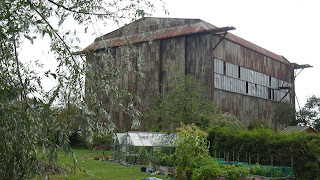The Pawlett Barrage Balloon Hanger must be one of the biggest enclosed spaces in Somerset, eclipsed only by the generator halls at the nearby Hinkley Point nuclear power station complex. I'd almost given up looking but an elderly local resident directed me down a narrow roadway leading down to the lower reaches of the River Parrett. Tucked away in a fold in the landscape, the site is is clearly well suited to discreet activities.
The process of inflating, deflating and manoeuvering a barrage balloon was time consuming and manpower hungry so the hanger was built in 1940 to house a single fully inflated balloon which could be deployed quickly and efficiently. The hanger measures 100 x 70 x 80 feet high and it dwarfs the buildings around it.
The efficacy of the cables was tested by flying specially modified aircraft into them. These aircraft had strengthened wing edges and it strikes me that it would have taken a lot of guts for a pilot to deliberately fly an aircraft into wires tethering a huge balloon full of highly inflammable hydrogen gas. This hanger and several at Sutton Coldfield, were the only facilities of this type in the country. Sadly the ones in the West Midlands are long gone so Pawlett has the only surviving example.
In the cemetery at the St John the Baptist parish church there is a memorial to the crew of a Blenheim which crashed onto Pawlett Hams on 5th July 1942. The aircraft along with the bodies of Sgt James Anderson, Sgt Adam Hogg and Sgt Gilbert McBoyle was recovered by local enthusiasts in 2007. My initial reaction was that the aircraft may have been lost during one of the aforementioned experiments. However, in looking up the incident, it seems that the aircraft (Blenheim IV R3912) was lost on a cross country training flight having taken off from RAF Bicester on a cross-country training flight. The aircraft involved in the balloon experiments flew from RAF Exeter and later RAF Churchstanton on the Blackdown Hills.
The picture shows, from left to right, Sgt Hogg, Sgt Anderson and Sgt McBoyle. It would seem that the aircraft was practising dives over the nearby Pawlett Hames ranges, to the east of the hanger. The ranges were used for the initial trials of 500lb and 1000lb bombs and for testing the dispersion of incendiary bombs. Later they were the location for testing the aerodynamics of objects falling at high speeds. In 1945 both the range and the hanger were decommissioned.


















